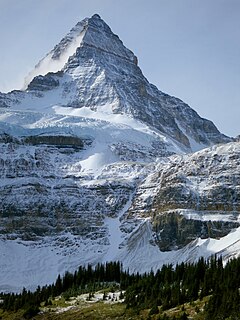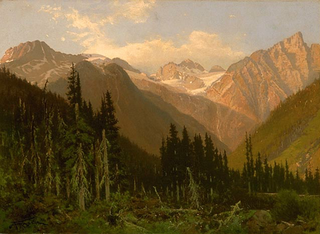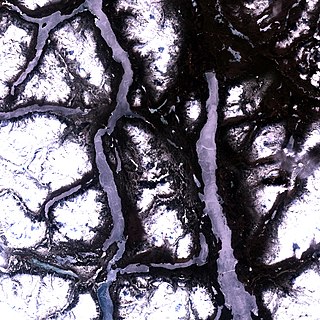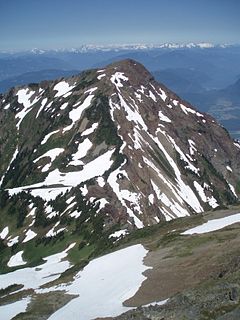
The Rocky Mountains, also known as the Rockies, are a major mountain range and the largest mountain system in North America. The Rocky Mountains stretch 3,000 mi (4,800 km) in straight-line distance from the northernmost part of western Canada, to New Mexico in southwestern United States. Depending on differing definitions between Canada and the United States, its northern terminus is located either in northern British Columbia's Terminal Range south of the Liard River and east of the Trench, or in the northeastern foothills of the Brooks Range/British Mountains that face the Beaufort Sea coasts between the Canning River and the Firth River across the Alaska-Yukon border. Its southernmost point is near the Albuquerque area adjacent to the Rio Grande Basin and north of the Sandia–Manzano Mountain Range. Being the easternmost portion of the North American Cordillera, the Rockies are distinct from the tectonically younger Cascade Range and Sierra Nevada, which both lie farther to its west.

Mount Waddington, once known as Mystery Mountain, is the highest peak in the Coast Mountains of British Columbia, Canada. Although it is lower than Mount Fairweather and Mount Quincy Adams, which straddle the United States border between Alaska and British Columbia, Mount Waddington is the highest peak that lies entirely within British Columbia. It and the subrange which surround it, known as the Waddington Range, stand at the heart of the Pacific Ranges, a remote and extremely rugged set of mountains and river valleys.

Mount Assiniboine, also known as Assiniboine Mountain, is a pyramidal peak mountain located on the Great Divide, on the British Columbia/Alberta border in Canada.

The Selkirk Mountains are a mountain range spanning the northern portion of the Idaho Panhandle, eastern Washington, and southeastern British Columbia which are part of a larger grouping of mountains, the Columbia Mountains. They begin at Mica Peak near Spokane and extend approximately 320 km north from the border to Kinbasket Lake, at the now-inundated location of the onetime fur company post Boat Encampment. The range is bounded on its west, northeast and at its northern extremity by the Columbia River, or the reservoir lakes now filling most of that river's course. From the Columbia's confluence with the Beaver River, they are bounded on their east by the Purcell Trench, which contains the Beaver River, Duncan River, Duncan Lake, Kootenay Lake and the Kootenay River. The Selkirks are distinct from, and geologically older than, the Rocky Mountains. The neighboring Monashee and Purcell Mountains, and sometimes including the Cariboo Mountains to the northwest, are also part of the larger grouping of mountains known as the Columbia Mountains. A scenic highway loop, the International Selkirk Loop, encircles the southern portions of the mountain range.

Atlin Lake is the largest natural lake in the Canadian province of British Columbia. The northern tip of the lake is in Yukon, as is Little Atlin Lake. However, most of the lake lies within the Atlin District of British Columbia. Atlin Lake is believed to be the source of the Yukon River although it is drained via the short Atlin River into Tagish Lake.

Mount Hector is a 3,394-metre (11,135-foot) mountain summit located in the Bow River valley of Banff National Park, in the Canadian Rockies of Alberta, Canada. The mountain was named in 1884 by George M. Dawson after James Hector, a geologist on the Palliser expedition. The mountain is located beside the Icefields Parkway, 17 km (11 mi) north of Lake Louise.

The Black Tusk is a stratovolcano and a pinnacle of volcanic rock in Garibaldi Provincial Park of British Columbia, Canada. At 2,319 m (7,608 ft) above sea level, the upper spire is visible from a great distance in all directions. It is particularly noticeable from the Sea-to-Sky Highway just south of Whistler, British Columbia. Distinctive and immediately identifiable, The Black Tusk is among the best known mountains in the Garibaldi Ranges of the Coast Mountains. The volcano is part of the Garibaldi Volcanic Belt which is a segment of the Canadian Cascade Arc, but it is not within the geographic boundary of the Cascade Range.

Pinecone Burke Provincial Park is a provincial park in British Columbia, Canada. It extends from the southwest corner of Garibaldi Provincial Park, west of Pitt Lake and Pitt River to include Burke Mountain in the City of Coquitlam. Most of the park is unserviced wilderness with very rough trails such as the Fools Gold Trail in the Boise Valley. There is canoe access to Widgeon Slough and from there hiking trails that lead to Widgeon Lake, and a network of old logging roads, hiking and mountain biking trails on Burke Mountain.

Height of the Rockies Provincial Park is a provincial park in the Canadian Rockies of south eastern British Columbia, Canada. It is located west of the Continental Divide, adjacent to Elk Lakes Provincial Park.

Golden Ears is the name of the summit that lies north of Maple Ridge, British Columbia and is visible from most of the western Lower Mainland. The mountain is in Golden Ears Provincial Park, and was originally referred to as Golden Eyries, possibly for Golden Eagles that were observed near the summit. There is confusion about the name, because of the twin summits the peak exhibits. Many people believe that the mountain is named because it looks like ears which become golden in the sunset light.

The Golden Ears is the name used by the Bivouac Mountain Encyclopedia for a group of mountains in the southern portion of Golden Ears Provincial Park, and visible to most of the Lower Mainland of British Columbia. It is a part of the Garibaldi Ranges, and is located in Golden Ears Provincial Park.
The Lucky Four Group is the name for a group of four mountains in the Cheam Range of the North Cascades of British Columbia east of the city of Chilliwack. The name of the region comes from the abandoned Lucky Four Mine near Foley Peak, and refers to the four summits in the eastern end of the range that are visible from the old mine access road that runs near Wahleach (Jones) Lake.

The Cheam Range is a mountain range in the Fraser Valley region of the Lower Mainland of British Columbia near the city of Chilliwack. The region is also a part of the Skagit Range of the Canadian Cascades and contains many rugged peaks.

The Misty Icefield is a high glaciated plateau in the Garibaldi Ranges of the Pacific Ranges of the Coast Mountains. It is located in the eastern part of Garibaldi Provincial Park and the northern portion of Golden Ears Provincial Park. The Misty Icefield was mapped and named in 1955, and rarely visited since, mainly due to its remote location. The area includes the Stave Glacier, and the Snowcap Glacier

The Five Fingers Group is a group of summits on the divide between Pitt Lake and Coquitlam Lake and north of Widgeon Lake, in British Columbia, Canada. The nearest populated areas are Anmore and Coquitlam. The peaks, all part of the same massif, are named for the fingers of a hand, but none of the names are official.

The Thumb is a mountain in the Five Fingers Group, a group of summits on the divide between Pitt Lake and Coquitlam Lake and north of Widgeon Lake, in British Columbia, Canada.
The Forefinger is a mountain in the Five Fingers Group, a group of summits on the divide between Pitt Lake and Coquitlam Lake and north of Widgeon Lake, in British Columbia, Canada.

The Little Finger is a mountain in the Five Fingers Group, a group of summits on the divide between Pitt Lake and Coquitlam Lake and north of Widgeon Lake, in British Columbia, Canada.

Skihist Mountain, also sometimes referred to as Skihist Peak, is the highest mountain in the Cantilever Range and in southwestern British Columbia, Canada. It is located on the southern boundary of Stein Valley Nlaka'pamux Heritage Park, about 20 km (12 mi) west of Lytton. It is the highest summit in the Lillooet Ranges, which lie between the Lillooet and Fraser Rivers, south of the Gates Valley and Seton and Anderson Lakes.

Mount Seymour Provincial Park is a park in Vancouver, British Columbia's North Shore Mountains. With an area of 35 square kilometres, it is located approximately 15 kilometres north of Downtown Vancouver. The park, named after Frederick Seymour, was established in 1936. Mount Seymour Provincial Park provides visitors with a variety of recreational activities and animals with natural habitat.















